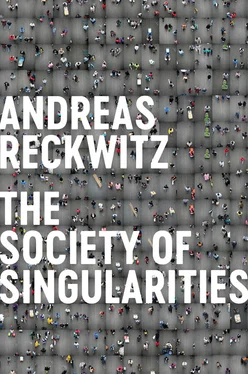Practices of Singularization II: Production and Appropriation
Regarding production , singularities are an object of design and fabrication, of labor and creation, of representation and performance. In an immediate sense, they are socially engendered, manufactured, and produced. This social production – this labor of singularization – can take very different forms depending on whether objects/things, subjects, places, events, or collectives are being created as singular.
Fundamentally, it is possible to distinguish the situation in which an idiosyncrasy (or an example of the general-particular) already exists and is singularized through a process of reframing – a sort of secondary production – from those situations in which an entity is intentionally produced from the beginning and from the ground up as singular. The reframing of idiosyncrasies takes place, for instance, when a previously ignored object is discovered to be a relic, a work of art, or a valuable antique, when a reclusive person is found out to be an “original” artist, or when an overlooked geographical region is reinterpreted as a valuable site of biodiversity. In these cases, the practices of production hardly differ from those of observation and evaluation. 40On the other hand, there are intentional acts of singularization that aim to produce brand new creations of unique things, subjects, places, events, or communities. This can involve such practices as hand-crafting an object, cultivating one’s own uniqueness (by adopting certain interests or updating a Facebook account, for example), painstakingly reenacting a complicated ritual, putting on a live concert, writing, composing, or preparing a meal.
Are these manners of producing singular entities structured in a fundamentally different way from the production of general elements? Without a doubt, the fabrication of singularities also involves instrumentally rational and normative-rational practices. The production of a film, for example, requires the coordination of a number of highly specialized activities within the framework of the movie industry. In the case of the labor of singularity, however, these activities are typically associated with practices of a specific sort: arrangements . Arrangement entails compiling heterogeneous objects, texts, images, individuals (etc.) into a whole that is as coherent as possible. The labor of singularity is thus often (and especially in late modernity) a matter of managing heterogeneity. In addition to functional components, arrangements can also include narrative and hermeneutic, aesthetic (visual, for instance), and ludic elements. Despite their necessary material aspects, the narrative and aesthetic features of arrangements mean that they are essentially a form of “immaterial labor,” though in a broad sense of the term. 41Historically, the arrangement of singularities is not necessarily connected to the aim of creating something new. 42This has normally been the case in modernity, however, so that here it is a matter of arranging novelties within the framework of what could be called a “creativity dispositif .” Yet even the production of novel singularities is not without preconditions, given that it depends on already existing elements – often on idiosyncrasies or standardized elements, but also on networks of narratives and symbols. Whereas standardized productions rely on immanent criteria of utility, practicality, and functionality (and thus do not really have to take their public function into account), the production of singularity must incorporate the real or imagined perspective of the public in the creation of its entities.
Regarding appropriation , 43an element of the social is only singular if it has been singularized in the situation of its use. Unlike instrumentally rational utility and routinized social interaction, which characterize the logic of the general, the appropriation of the particular has the structure of lived experience . 44A singular object or thing, a singular subject, a singular place, a singular event, a singular collective – they are all experienced, which can only happen if they are truly experienced as unique and have a unique social reality. Experience is a mental but also physical process of appropriating the world in which objects of attention are perceived by the senses. As lived experience, sensory perception goes beyond the function of gathering information, which is the typical and essential function of perception within the framework of instrumentally rational activity. Lived experience is perception for its own sake – a sort of self-referential perception. Whereas, in the social logic of the general, appropriation involves manipulating the world in order to achieve a specific goal, lived experience is a matter of processing and receiving the world.
What is central to practices of experience – whether attending an opera or meditating, base flying or visiting a city, going to the opening match of the World Cup or simply hearing the national anthem on the radio – is that the singular entities in question affect their recipients. 45It is the affective nature of the logic of singularities that structures, in a specific way, appropriation as experience. Whenever singular objects, subjects, places, events, or collectives are appropriated, intensive (positive or ambivalent) emotions are often at play: passion and admiration; affection and inspiration; shock and desire; fear and disgust; feelings of elation, pride, or beautiful harmony. And even when the intensity of these emotions is relatively weak – if someone is merely stimulated by something interesting, cool, or exciting – they remain at the heart of the matter. In that singular entities affect people, their appropriation incites a degree of emotional intensity. The latter, however, should not be understood as a behaviorist stimulus-and-response sequence but rather as an interpretive praxis: only those who interpret nature in a certain way, for instance, are able to “experience” it. 46
Lived experience can take on a wide variety of forms. It can have an intersubjective character (when a group or audience is present), or it can involve a private act of engaging with an object. It can be of a primarily mental nature, with little or no bodily involvement, or it can expressly involve an active physical practice. In many cases, too, production and experience can go hand in hand (when people play a game together, for instance). Fundamentally, however, it must be said that subjective experience is not self-contained but is rather itself a component of social praxis – of the practices of appropriation that give it shape in a specific way. Compared to the appropriation of social elements in the mode of the general, which is relatively stable, the appropriation of singularities is riskier and more unpredictable on account of its psycho-physical aspect. It can fail altogether, it is not something that can be forced, and it may not result in any real experience at all.
Performativity as a Mode of Praxis and Automated Singularization
Regarding the social logic of the general, I discussed above a general structure of social praxis – a mode of praxis – that more or less applies to all four of the practices of observation, evaluation, production, and appropriation: the mode of instrumentally rational and socially coordinated activity. The social praxis of the general is thus essentially one of labor and interaction . How, in this regard, do things look in the social logic of singularities? What is its overarching mode of praxis? Basically, the social praxis of the particular has the structure of a performance , so that performativity is its central characteristic. In the mode of the singular, the social manifests itself in the situation of one or more people performing something for an audience that is meant to have cultural value. Singular entities are not primarily used in an instrumental way (like instrumentally rational activity) or treated normatively (like normative activity); rather, they are presented in the mode of performativity. Singular subjects, places, and objects are presented; as events, singular temporalities have a performative character; and singular collectives live off of this collective performativity. Singularities thus exist as performances of singularity before a social audience. 47
Читать дальше












